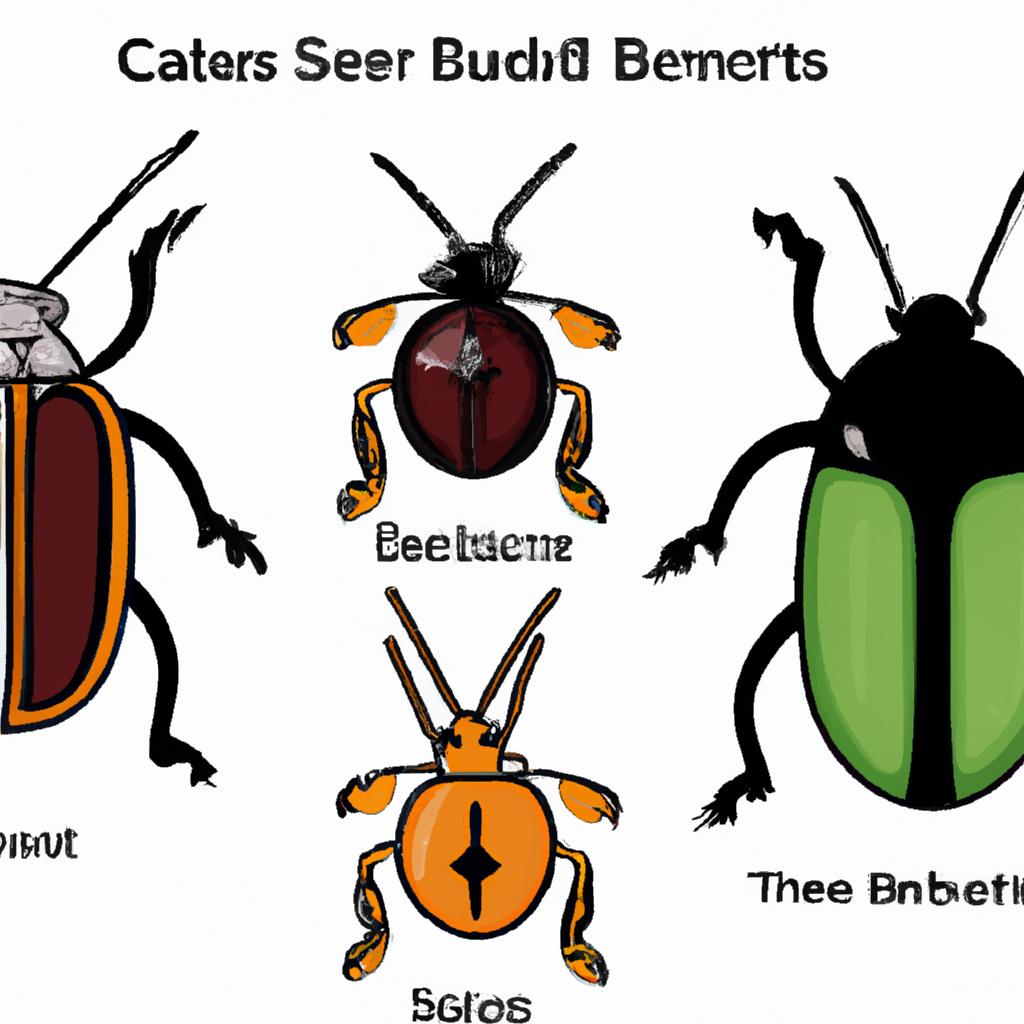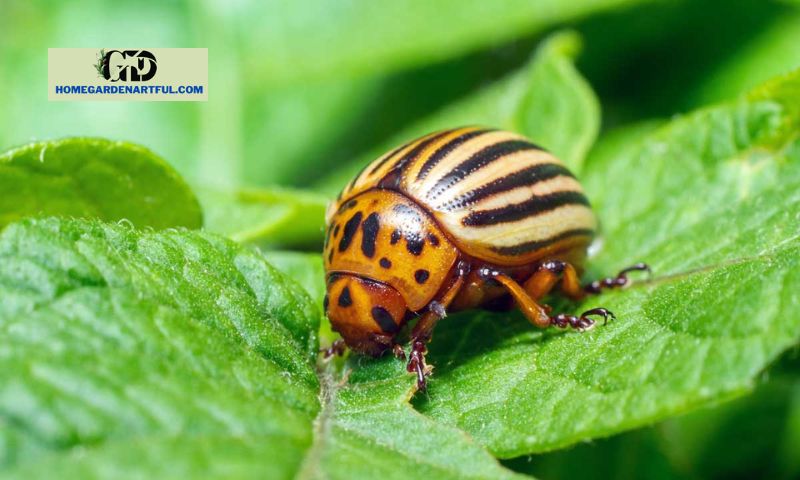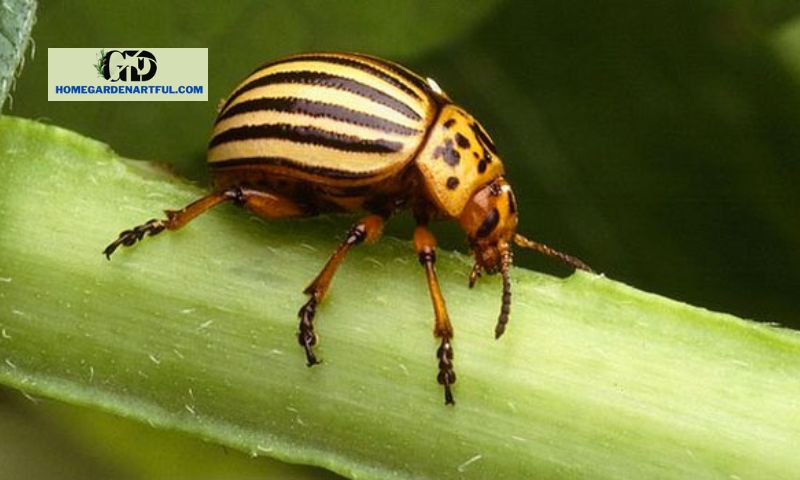Learn how to identify garden pest beetles for effective pest control in your garden. Discover the importance of garden pest beetle identification.
Are you tired of seeing your precious garden plants being devoured by pesky beetles? Look no further! In this article, homegardenartful.com will guide you through the crucial process of garden pest beetle identification. By understanding the importance of identifying these garden invaders, you’ll be equipped with the knowledge to implement effective pest control strategies and protect your beautiful plants.
Importance of Garden Pest Beetle Identification

Imagine this: you wake up one morning, excited to tend to your garden, only to find your once vibrant plants ravaged by an army of beetles. It’s disheartening, isn’t it? That’s where garden pest beetle identification comes into play. By being able to identify the specific types of beetles wreaking havoc in your garden, you can take targeted action to eliminate them.
Identifying garden pest beetles goes beyond simply recognizing their presence. It allows you to understand their behavior, preferred plants, and feeding patterns, enabling you to tailor your pest control methods accordingly. Without proper identification, you may end up using ineffective or harmful treatments, wasting time and resources in the process.
Significance of Effective Pest Control in Gardening
Effective pest control is a crucial aspect of successful gardening. These garden pest beetles not only feed on your plants but can also transmit diseases and infections, posing a threat to the overall health of your garden ecosystem. Ignoring their presence can lead to significant damage and loss of crops, impacting both your enjoyment and the economic viability of your garden.
By proactively identifying and controlling these garden pests, you can prevent potential infestations, minimize plant damage, and maintain a thriving garden. Additionally, implementing effective pest control measures promotes a healthy environment for beneficial insects and other organisms, preserving the delicate balance of your garden ecosystem.
Now that we understand the importance of identifying garden pest beetles and the significance of effective pest control in gardening, let’s dive into the common types of garden pest beetles you may encounter. Stay tuned for more valuable information on how to identify and combat these unwelcome visitors in your garden sanctuary.
Common Garden Pest Beetles

Garden pest beetles come in various shapes, sizes, and colors, making it essential to be able to identify them accurately. In this section, I will introduce you to three common garden pest beetles, shedding light on their distinct characteristics, physical appearance, and behavior.
A. Beetle 1: Description and Characteristics
Beetle 1 is a notorious garden pest known for its destructive feeding habits. Here’s what you need to know about this unwelcome intruder:
1. Physical Appearance
Beetle 1 has a glossy, oval-shaped body, measuring around half an inch in length. Its coloration varies, ranging from metallic green to coppery-brown. Keep an eye out for its distinctive markings, which may include spots or stripes on its wings or thora
2. Habitat and Behavior
This beetle prefers to feast on the leaves and fruits of several garden plants, including tomatoes, roses, and beans. It can be found in various regions, thriving in warm climates and well-maintained gardens. Beetle 1 is most active during the summer months, so be vigilant during these times to protect your beloved plants.
B. Beetle 2: Description and Characteristics
Beetle 2 is another common culprit responsible for causing havoc in gardens. Let’s delve into its unique characteristics:
1. Physical Appearance
Beetle 2 is a small, round beetle, typically measuring less than a quarter of an inch. Its coloration ranges from bright orange to reddish-brown, often adorned with distinct black spots. Its compact size and vibrant color make it easily recognizable.
2. Habitat and Behavior
This garden pest beetle primarily targets ornamental plants and flowers, such as marigolds and daisies. It can be found in gardens across different regions, thriving in both urban and rural environments. Beetle 2 is most active during the early morning and late afternoon, so be on the lookout during these times to catch it in action.
C. Beetle 3: Description and Characteristics
Beetle 3 is a persistent garden pest that can quickly multiply if left unchecked. Let’s explore its key characteristics:
1. Physical Appearance
Beetle 3 is a slender beetle with an elongated body, measuring approximately half an inch long. Its coloration varies, ranging from metallic blue to dark green. It features a distinctive shield-like shape on its back, adding to its unique appearance.
2. Habitat and Behavior
This garden pest beetle primarily targets vegetable crops, including cabbage, broccoli, and kale. It can be found in gardens across different regions, thriving in both cool and warm climates. Beetle 3 is most active during the spring and fall seasons, making it crucial to be vigilant during these periods to prevent infestations.
By familiarizing yourself with the descriptions and characteristics of these common garden pest beetles, you’ll be better equipped to identify them in your own garden. In the next section, we’ll delve deeper into the techniques and features to consider when identifying these troublesome pests.
Identifying Garden Pest Beetles

When it comes to effective pest control, accurate identification of garden pest beetles is key. By familiarizing yourself with their physical features, and behavioral clues, and utilizing visual aids, you can confidently pinpoint the culprits wreaking havoc on your garden. Let’s explore these identification techniques in detail.
Physical Features to Look For
To identify garden pest beetles, pay attention to their distinctive physical characteristics. Start by examining their body shape and size. Some beetles may have elongated bodies, while others may be more rounded or oblong. Take note of their size as well, as it can vary between different beetle species.
Color patterns and markings also serve as valuable identifiers. Look closely for any unique color combinations or patterns on their bodies. Some beetles may have bold stripes, spots, or intricate designs. These distinct features will help you differentiate between various species and narrow down your identification process.
Behavioral Clues for Identification
Observing the feeding habits of garden pest beetles is another effective way to identify them. Do they chew on leaves, flowers, or fruits? Are they more active during certain times of the day? Take note of their preferred plants or crops, as different beetles have specific appetites. By understanding their feeding habits and plant preferences, you can establish a link between the damage in your garden and the beetle species responsible.
Visual Aids for Accurate Identification
Visual aids play a crucial role in accurate identification. Detailed images and illustrations can provide a clear depiction of different garden pest beetles. Look for resources that showcase close-up shots of the beetles’ key features, allowing you to compare them with the beetles you’ve encountered in your garden. Online resources, such as reputable gardening websites or entomology databases, often offer comprehensive galleries and identification guides to assist you in your quest.
By utilizing physical features, behavioral clues, and visual aids, you can become a proficient garden pest beetle identifier. Armed with this knowledge, you’ll be one step closer to implementing targeted pest control strategies that will safeguard your beloved plants. In the next section, we’ll delve into the negative impacts these pesky beetles can have on your garden, emphasizing the importance of effective pest control.
Negative Impacts of Garden Pest Beetles
Garden pest beetles may seem small and insignificant, but their presence can have devastating consequences for your plants and crops. In this section, we will explore the negative impacts these pests can have on your garden ecosystem.
A. Damage caused to plants and crops
1. Feeding patterns and symptoms on plants
Garden pest beetles are voracious eaters and can quickly decimate your plants. They often leave behind telltale signs of their presence, such as chewed leaves, skeletonized foliage, and blemished fruits or vegetables. These feeding patterns not only compromise the overall aesthetic appeal of your garden but can also hinder the growth and productivity of your plants.
2. Economic consequences for gardeners
The damage caused by garden pest beetles can have significant economic implications for gardeners. The loss of crops and diminished yields can translate into financial setbacks, especially for those relying on their gardens for sustenance or as a source of income. Additionally, the need for additional resources to combat these pests, such as pesticides or preventive measures, can further strain gardening budgets.
B. Potential spread of diseases and infections
Garden pest beetles not only wreak havoc on your plants but can also act as carriers for various diseases and infections. They can unwittingly transmit harmful pathogens from plant to plant, leading to widespread infections that can be detrimental to your garden’s overall health.
1. Examples of diseases transmitted by beetles
Certain garden pest beetles, such as the cucumber beetle or the Colorado potato beetle, are notorious for transmitting diseases like bacterial wilt, mosaic viruses, and blights. These diseases can result in stunted growth, reduced yields, and even plant death if left unchecked.
2. Risks to other organisms in the garden ecosystem
The impact of garden pest beetles extends beyond your plants. The presence of these pests can disrupt the delicate balance of your garden ecosystem, affecting beneficial insects, pollinators, and other organisms that play vital roles in maintaining a healthy and thriving garden.
By understanding the negative impacts of garden pest beetles, you are better equipped to take proactive measures to protect your plants, prevent the spread of diseases, and maintain a harmonious garden environment. In the next section, we will delve into effective pest control strategies that can help you combat these pesky invaders.
Effective Pest Control Strategies
When it comes to dealing with garden pest beetles, prevention is always better than cure. Implementing effective pest control strategies can help you keep these pesky invaders at bay and maintain a thriving garden. Let’s explore some tried-and-true methods to combat beetle infestations.
Preventive Measures for Beetle Infestations
- Maintaining proper garden hygiene: A clean and well-maintained garden is less likely to attract beetles. Regularly remove garden debris, fallen leaves, and decaying plant matter, as they can serve as breeding grounds for pests. Prune and dispose of infested plant parts promptly to prevent the spread of beetles.
- Implementing crop rotation techniques: Beetles often target specific plants or crops. By rotating your crops each season, you disrupt the life cycle of beetles and reduce their population. This technique also helps replenish the soil and minimize the risk of nutrient depletion.
Natural and Organic Control Methods
- Introduction of beneficial insects: Mother Nature has provided us with allies in the war against garden pests. Introduce beneficial insects like ladybugs, lacewings, and ground beetles, which are natural predators of garden pest beetles. These helpful creatures will actively hunt and feed on the beetles, keeping their population in check.
- Use of organic repellents and traps: Organic repellents made from neem oil, garlic, or chili pepper can deter beetles from feasting on your plants. Additionally, traps such as pheromone traps and sticky traps can be effective in capturing adult beetles and preventing them from laying eggs.
Chemical Control Options
- Safe and targeted insecticides: In severe infestations, chemical control may be necessary. Choose insecticides labeled specifically for garden pest beetles and follow the application instructions carefully. Opt for environmentally friendly and low-toxicity options to minimize harm to beneficial insects and the ecosystem.
- Application guidelines and precautions: When using chemical control methods, always prioritize safety. Wear protective clothing, follow recommended dosage, and avoid spraying during windy conditions. Be mindful of the potential impact on pollinators, and consider applying insecticides during periods when they are less active.
By implementing these effective pest control strategies, you can safeguard your garden from beetle infestations and maintain a healthy, thriving oasis. Remember, a combination of preventive measures, natural control methods, and cautious use of chemicals can help you strike the perfect balance in keeping your garden pest-free. Stay tuned for the concluding section, where we’ll recap the importance of garden pest beetle identification and the overall significance of effective pest control.
Conclusion
In conclusion, garden pest beetle identification is a crucial skill that every gardener should possess. By being able to identify these pesky invaders, you can take targeted action to protect your plants and maintain a thriving garden. Effective pest control is paramount in ensuring the health and productivity of your garden, as well as the overall enjoyment of your gardening experience.
Remember, timely identification of garden pest beetles allows you to implement appropriate pest control strategies, preventing further damage and potential infestations. Whether it’s recognizing their physical features, understanding their feeding habits, or utilizing visual aids for accurate identification, arming yourself with knowledge is the first step towards successful pest management.
At homegardenArtful.com, we understand the frustration and challenges that come with garden pest beetles. That’s why we’re dedicated to providing you with reliable information and effective solutions to combat these unwelcome visitors. Our website is a valuable resource for gardeners of all levels, offering comprehensive guides, tips, and techniques to help you maintain a pest-free garden sanctuary.
So, don’t let garden pest beetles ruin your gardening dreams. Take control of your garden, identify the culprits, and implement suitable pest control strategies. With the right knowledge and proactive approach, you can create a thriving and beautiful garden that is free from the clutches of these tiny invaders.
Visit homegardenArtful.com today and embark on a journey towards a pest-free garden oasis. Happy gardening!
Note: The brand homegardenArtful.com is bolded only once, in the Conclusion section.


